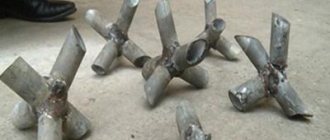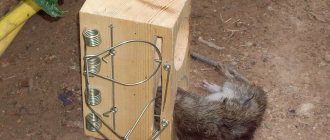It is useful to keep in mind that a homemade rat trap can be even more effective than standard purchased products - this fact has been repeatedly confirmed in practice. A typical example is when rats bypass a conventional mousetrap, feeling that this device is fraught with danger, but quickly fall into the trap of a new design that is not yet familiar to them.
At the same time, to catch a pest it is not at all necessary to make something complex, cumbersome and requiring serious skills. It is known that everything ingenious is simple, and rat traps assembled with your own hands from scrap materials are the best proof of this: the lack of expensive parts, time or skills here is compensated by the ingenuity of the creator and the ingenuity of the design itself.
As you will see below, a very effective trap can be assembled in just a few minutes from ordinary plastic bottles, a bucket or a pan, and there are many options for such traps.
Below are descriptions of the 8 most effective simple homemade rat traps and illustrative examples of their work in practice...
Option #1: Tilting Trap
The operating principle of this design is that the animal, approaching the bait, falls into the trap. This mechanism can be implemented in many ways.
Here's the simplest one:
- Make a tunnel out of cardboard (you can also use a piece of wide plastic pipe);
- Place it on the edge of the table so that half of the tunnel overhangs the edge (it helps to lightly tape it to the table so the rat can't move it);
- Place bait at the very edge of the tunnel;
- Place a barrel or deep bucket under the site of the expected capsize.
The animal, attracted by the smell of the bait, will climb along the tunnel, knock it over at the edge of the table and fall into the container with it. The video below shows how this happens:
Agree, what could be simpler?
There may be several options for making such a homemade rat trap. For example, a tilting bridge can be placed directly on the edge of a bucket, and a ladder can be connected to it:
For this purpose, you can use a piece of whatman paper with slits to cover the bucket. The rat climbs onto the Whatman paper for the bait and falls through the slits into the bucket:
On a note
If you use a bucket or can to catch a rat, it is useful to first pour water into it - without water, the animal will easily jump out of the trap. In addition, it will be easier to catch the pest in water (just don’t forget to wear thick construction gloves before doing this).
By the way, you can make a mousetrap using the same principle with your own hands from a plastic bottle. In this case, a bottle with an open neck is placed on the edge of the table (or you can make a special inlet hole), bait is placed in it, and the bottle is tied by the neck with a thread to something heavy on the table itself. The mouse climbs into the bottle, halfway to the bait, knocks it over with its weight, and the entire trap with the prey hangs on a thread:
On a note
It will not be possible to catch a rat in a bottle in this way - the animal will easily jump out of the overturned trap. Perhaps, as an option, you can make a tunnel out of a bottle like the paper one discussed above, cutting off its bottom and neck, and then catch the pest in a bucket or barrel.
Option number 2: rat traps made of plastic bottles
The traditional version of this trap looks like this:
- The top part of the bottle is cut, it opens slightly, a long rod is attached to it, to which, in turn, a tourniquet is attached, which plays the role of a spring;
- Near the bottom of the bottle, through a hole in the wall, a trigger is attached, to which the bait is attached;
- The door from the neck of the bottle is attracted by a rope to the body of the bottle - this will allow it to slam shut when the animal pulls the bait.
Capture is simple: the rat climbs into the bottle, pulls the bait, and the rubber band slams the door. That's it, the animal is caught. The video shows how this design works and how to assemble it:
And here is another example of a simple but very effective rat trap, which you can easily make with your own hands from a plastic bottle:
- The bottle is strung on a rod (for example, on a thick wire);
- Then the outside of the bottle is coated with bait - sour cream, porridge, stew;
- The rod is placed on the edges of a bucket or barrel;
- A bridge made of boards is connected to the bottle.
It is also useful to read: Which rat and mouse repeller is better: a review of devices and reviews about them
Then everything is simple: the rat climbs along the bridge to the bottle, climbs on it to lick the bait, the bottle spins, and the animal falls into the bucket. Like this:
A similar design can be made from a bucket and a beer can. The photo below shows a corresponding example:
The disadvantage of rat traps with a rotating bottle (or jar) is that they are bulky - it is not always convenient to use them at home.
It’s easier with mice - for lovers of beautiful solutions, a compact mousetrap made from a plastic bottle has been invented, which, if desired, can be placed under a table or in a closet. The following video shows how to assemble such a trap from available materials:
The main thing in this design is to correctly guess the center of gravity of the bottle.
If you take a suitable bottle, you can use it to make a rat trap using the same principle. It is only important to keep in mind that, given enough time, the animal may try to gnaw through the walls of the trap and thereby get out of it.
Option number 3: covering live trap
This is perhaps the simplest version of a homemade rat trap. To catch a rat or mouse with it, just take a pan and a coin of suitable size - turn the pan upside down, tilt it slightly and rest one edge of it against a coin placed on its edge.
Bait is placed under the pan. When the rodent climbs for the bait, it will certainly touch the coin, it will tip over and the pan will cover the animal.
Here is an example of an implementation where a jar is used instead of a pan:
The disadvantage of the design is frequent false alarms (when a rat touches a container or coin before it has climbed inside the rat trap).
A more sophisticated homemade trap of this type is the improved “coin container.” For example, a container can be rested on an unstable stand, a thread can be tied to the stand, the thread can be thrown over a spacer in the container and the bait can be tied to it:
The rat will sneak under the container, pull the bait and move the “guard”.
Another option is to use a strip of cardboard of sufficient height instead of a coin with a special corner for attaching bait:
Here the animal, pulling the bait, knocks over the cardboard and covers itself with the trap.
It is only important to keep in mind that to make homemade rat traps you need to take a container that is heavy enough so that the rat cannot move it.
The video below shows another interesting example of such a rat trap:
Option #4: cage traps
Such designs are characterized by high reliability, durability and efficiency, but they are quite difficult to make yourself. Their manufacture requires special materials and parts: the body itself is made of durable steel mesh, metal or wood panels, and the trigger mechanism is based on a spring. However, with sufficient desire and skill, assembling such a device with your own hands will not take much time.
The principle of operation of the rat trap is as follows:
- The cage has a rising door with a guard - when alert, the trap door opens upward with spring tension;
- At the end of the cage, a bait is attached to a hook, the other end of the hook holds a guard;
- When the rat pulls the bait, the gate lowers and the door slams shut.
The video below shows examples of manufactured rat traps of this type:
Steel mousetrap FIT
The classic option is a mousetrap in the form of a wooden base with a durable steel mechanism. It has maximum sensitivity, so theft of the bait is eliminated, since the device slams shut instantly. These traps are the most popular among the people: they are cheap and work effectively.
But they also have disadvantages. This is not the fastest way: sometimes mice do not die immediately, but after a few hours. The tree absorbs the smell of dead pests, so after some time this design will be unsuitable for use. The cost is up to 70 rubles.
Option #5: Tunnel Trap
The entrance hole of the tunnel rat trap is made in the form of a valve with sharp petals. The operating principle of such a device is as follows:
Such structures are often used to catch courts, mice and rats in garden plots - in this case, the structure is made from a piece of pipe, at each end of which a valve is installed. The trap is then installed in the underground wormhole. In the end, it doesn’t matter from which side the mole (or rat) approaches the trap - the animal will still be caught.
It is also useful to read: Poison for rats and mice Storm (manufactured by BASF) and reviews of its use
Here is another example of a trap of this type:
Mousetrap Mr.Mouse
This is a classic version of a mousetrap, but with an improved design of the bait area. It is made of plastic that does not get dirty and does not absorb odors. Therefore, the design can be used repeatedly.
This design is safe compared to steel traps, since it functions on the principle of a large clothespin. As customer reviews indicate, such devices are easy to use. The cost of the product is about 80 rubles.
The effective functionality of rat traps allows you to quickly remove rodents from your home. Thanks to your skills, you can make the device yourself. According to reviews, these are effective devices that will also save money.
Option number 6: snare
Generally speaking, catching rats with snares is quite problematic due to the small size of the animals. However, if you try, you can still catch the pest, and there is even a small life hack that allows you to make such a rat trap with your own hands from improvised means.
For this you need:
- Cable tie;
- A piece of fishing line;
- Heavy load - for example, a wrench;
- Paper clip;
- Bait - for example, a crust of bread.
This is how a homemade rat trap made from a cable tie works in practice:
On a note
When making this trap, it is important to choose the right weight of the load. If it is too small, it will not tighten the tie with the necessary force, and the rat will run away. If the load is too heavy, then using such a structure as a live trap will not work - the animal’s ribs will be broken by the loop.
Electrical
A modern design that solves all problems at once - it catches, it kills. The likelihood of escaping is reduced to a minimum. The rodent dies without reaching the bait.
Electric rat traps
On a note!
An electric rat trap is one of the most expensive devices. The cost of the design is from 1 thousand rubles. up to 10 thousand rubles
The device operates from several power sources at once - city network, batteries, batteries. This allows you to place the device in any convenient place. The electric trap operates simply and quickly. The metal plate on which the rodent steps is energized. The plate tilts, shorts the wires, and the rat receives a fatal shock.
Option #7: Zürner trap
This classic trap works on the same principle as the tipping rat traps described above. Its difference lies only in the completeness of the design and appearance: the Zürner trap is a wooden house with two entrances, in which the bait is located in the middle of the “corridor”, and the floor on both sides of it is made of boards on hinges. When the animal approaches the bait, the board collapses under its weight, the animal falls into a large closed chamber, after which the board returns to its original position on a hinge.
The figure below shows a diagram of such a rat trap:
Thanks to its successful design, the Zürner trap can catch several rats at once.
As a rule, such a trap is made independently from wood, since the industry has not established the production of Zürner traps. Despite its effectiveness and certain advantages, the Zürner trap is rarely used in practice, largely due to the complexity of manufacturing.
Mousetraps
Which rat traps and traps to choose depends on personal preference. Considering the reviews, mousetraps are in demand. The characteristics of rat traps vary, but they are usually made of wood, plastic, or steel. The devices have a long service life, as well as the ability not to touch the caught pest. But you should take into account the dimensions of the device, since a very small mousetrap will not be harmful to the rat.
As confirmed, the “Super Cat” device works effectively. Inside the trap there is bait, thanks to which the rat gets inside. The mechanism is automatically activated and slammed shut. It will not be difficult to remove a dead rodent: you just need to shake it out.
Do not use contaminated rat traps. You can install a rat trap after treatment with a solution of baking soda and drying.
Live trap is a popular type of mouse trap that is in demand among consumers. This is a trap cage with a tin door. In the middle there is a bait, the smell of which attracts the rodent. When an animal wants to take a treat, the trap is closed with a metal spring. As a result, the beast will be locked inside.
Option No. 8: glue rat trap
Ready-to-use glue traps for rodents are available on sale today. However, such a trap is often prepared independently.
Making a glue rat trap is simple: take a special glue for rodents (for example, RaTrap, Alt, EuroGuard), spread it on a piece of cardboard, and place bait on it in the middle. The rat, attracted by the smell, tries to get the bait and puts at least one paw on the glue. Realizing that she cannot come unstuck, she begins to frantically try to escape, puts her other paws in the glue, or even sticks her head. After this she can no longer get out.
If the rat is not freed, it will die of thirst only after a few days. This is the main disadvantage of glue traps: often you have to throw out such a rat trap with a still living rodent (sometimes squealing periodically), which is difficult for especially impressionable people.
On a note
A significant disadvantage of glue traps for rodents is also the possibility of pets getting into them - a cat or dog can easily get dirty in the glue. Washing off the sticky mass is very problematic; it’s easier to cut off the sticky piece of wool.
Features of rat control
If you decide to make a mechanism such as a rat trap with your own hands, then first become familiar with the habits and preferences of rodents. Experienced exterminators who have been waging war against rodents for many years give four pieces of advice.
- Delicious bait. The success of catching animals depends 80% on what you put in the rat trap. Therefore, choose aromatic and appetizing foods for bait. The rat will definitely be lured by the smell of vegetable oil (especially fried), smoked lard, sausage, seeds, beer, fresh bread, cheese.
- Definition of a hole. It is better to place the trap near the hole. This place has the largest concentration of rodents, so the fight will be more effective. As reviews show, you can determine whether a hole is residential or not using the following trick. Crumple up a piece of paper and easily plug the hole with it. Wait a day. If the hole is inhabited, then the inhabitants will push out the paper, chew it and scatter it on the floor.
- Installation of traps. Rats prefer to remain unnoticed, so they move along walls. Rodents avoid illuminated areas and almost never go out into the open. Given these features, it is recommended to install rat traps near the walls, against the movement of tailed pests.
- Cleanliness of the trap. Be sure to monitor the condition of the rat trap. As soon as a rodent gets into it, remove it immediately. Wash the rat trap thoroughly with soda or ash lye. Ventilate the washed mechanism well, and only then reinstall it. Otherwise, the rodents will smell the smell of a dead relative and will never stick their nose into the trap.
And also a few words about commercially available lethal rat traps (traps)
All of the homemade rat traps described above have an important feature - they allow you to catch the animal alive (the so-called live traps).
However, you can also effectively fight rats using commercially produced traps that will kill rats. For example, among the most popular are the following:
- A standard trap-press (popularly often called a mousetrap) - it can have several modifications;
- Tunnel trap similar to Clean Kill Mouse Trap from Victor;
- Electric rat trap (battery-powered, and there are models that automatically place a killed rat in a special compartment, allowing you to destroy several rodents at once).
In conclusion, it is worth noting that the effectiveness of a particular trap, be it homemade or industrially produced, largely depends on the correct choice of bait. Read more about choosing baits in a separate article: The best baits for rats and mice.
Useful video: a clear example of how an electric rat trap works
How to install correctly
Traps should be installed in places where pests appear; they can be identified by a large accumulation of excrement. In an apartment, it is best to place a trap in the kitchen. If we are talking about a private house, then a cellar or basement would be the best choice for placing mousetraps.
10 Best and Unique Rat Traps
In homes with garbage disposals, the best advice is to place traps on the floors behind waste disposal areas. Particular attention must be paid to the first floor, where all garbage is dumped.











